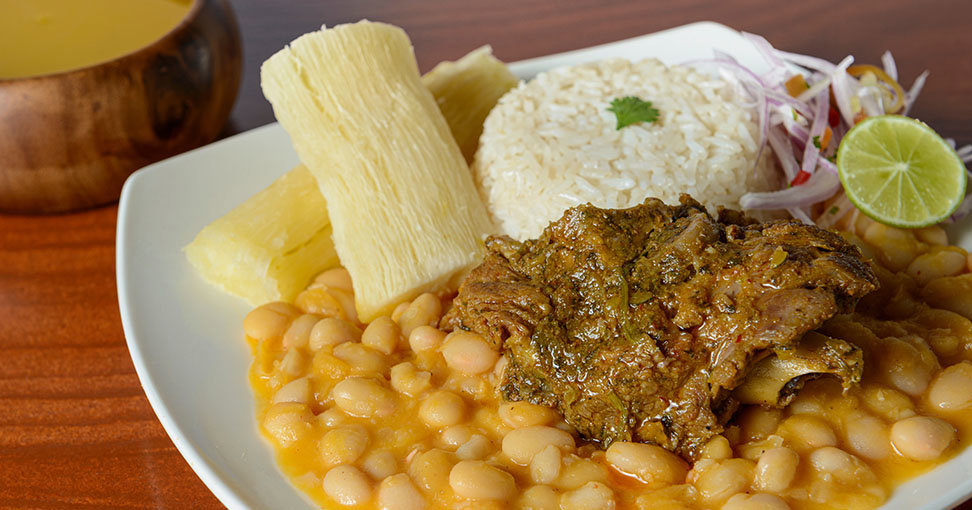Seco de cabrito a la norteña

Seco de cabrito: A classic of Peruvian gastronomy
Seco de Cabrito is an iconic dish of Peruvian cuisine that has its roots in the colonial era, when Spanish food merged with local culinary traditions. It also incorporates Arab influences, evident in the use of spices and cooking techniques. Thanks to its deep flavor and the tender texture of the meat, Seco de Cabrito is a favorite at social events and festivals in northern Peru—particularly in regions like Lambayeque, Piura, and Trujillo—where it plays a leading role in patron saint festivities and important celebrations.
Ingredients and tradition
"Cabrito" refers to a young goat, prized for its tender, low-fat, and protein-rich meat, making it a healthy and delicious choice for a balanced diet. The preparation of Seco de Cabrito includes traditional ingredients such as ají panca (a Peruvian red chili pepper), chicha de jora (a fermented corn drink) or dark beer, garlic, tomato, and squash, among others, which contribute to the dish's unique and characteristic flavor. This combination of ingredients creates an aromatic and comforting stew, ideal for sharing at family gatherings and special events.
How seco de cabrito Is served
To fully enjoy this dish, Seco de Cabrito is usually served with beans, white rice, golden potatoes, boiled cassava, and onion salad (zarza de cebolla). These side dishes not only complement the texture and flavor of the goat meat but also enhance the culinary experience by adding variety and color to the plate.
The innovation of great Peruvian chefs
Internationally renowned Peruvian chefs such as Gastón Acurio, Virgilio Martínez, and Mitsuharu Tsumura have elevated Seco de Cabrito by creating innovative interpretations. Thanks to their talent and creativity, they have developed modern versions that honor tradition while incorporating contemporary techniques and new ingredients. These renditions have been widely praised by culinary critics and have helped cement Seco de Cabrito as a culinary symbol both in Peru and around the world.
A dish that celebrates Peruvian culture
More than just a stew, Seco de Cabrito is a living expression of Peruvian identity. Its preparation brings together ancestral ingredients, inherited techniques, and the festive spirit of the northern regions. It is a dish that speaks of history, cultural blending, and the warmth of family gatherings.
Each bite connects us to the traditions of towns like Lambayeque, Piura, and Trujillo, where cooking not only nourishes but also unites and celebrates. Whether served on a humble table or reimagined by top chefs, Seco de Cabrito retains its essence and continues to win over palates.
Tasting it is to dive into a culinary legacy full of flavor, passion, and national pride. A true emblem of Peruvian gastronomy that deserves to be shared and preserved.
RECIPE
Ingredients:
- 1 kg of young goat meat (preferably shoulder or hip)
- 1 onion
- 1 cup of chicha de jora
- Blended cilantro to taste
- 1 tablespoon of special chili paste (ají especial)
- 1 teaspoon of garlic
- 1/2 teaspoon of cumin
- 1/2 teaspoon of black pepper
- Oil
- Salt to taste
- Norteña-Style Cabrito Recipe
Preparation of the goat
To achieve a more intense flavor, it’s best to marinate the meat the night before. Wash the goat pieces thoroughly and place them in a bowl. Add chopped cilantro, ají especial, cumin, pepper, one cup of chicha de jora, and salt to taste. Mix well so all the ingredients blend together, then refrigerate until the next day.
The next day, in a large pot, heat a bit of oil over low heat and sauté finely chopped onion along with ground garlic. Cook until the onion turns golden or caramel-colored. Then, add the meat with all the marinade and let it brown well.
Add one and a half cups of hot water, cover the pot, and cook over low heat for about an hour and forty minutes. It’s important to monitor the cooking so it doesn’t dry out—if the liquid reduces too much, add a bit more hot water as needed to maintain steady cooking and achieve tender, juicy meat.
Once the meat is thoroughly cooked and tender, check the seasoning, adjust if necessary, and remove from heat. Serve with mashed beans, boiled cassava, white rice, and a sarsa criolla (onion salad). The goat’s juices combined with these sides make the dish irresistible.
Side Dishes for Seco de Cabrito
Sarsa Criolla
Sarsa criolla adds freshness to the dish. To prepare:
- Thinly slice a red onion (julienne style).
- Add finely chopped ají limo or rocoto chili.
- Mix in chopped cilantro.
- Dress with lime juice and salt to taste.
Beans
Soak the beans in cold water overnight.
The next day, cook them in clean water until soft.
Lightly mash the beans until partially broken down.
In a separate pan, prepare a sauté (aderezo) with onion, garlic, cumin, salt, and pepper.
Add this sauté to the cooked beans and mix well.